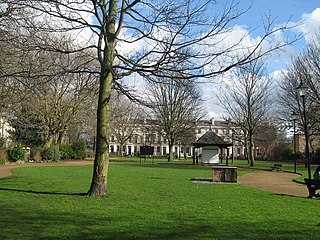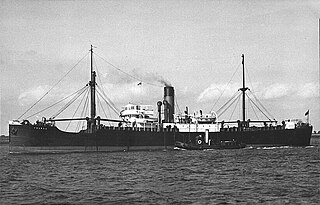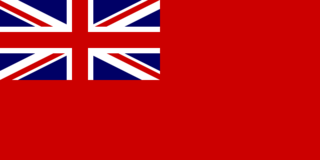
The Tower Hill Memorial is a pair of Commonwealth War Graves Commission memorials in Trinity Square Gardens, on Tower Hill in London, England. The memorials, one for the First World War and one for the Second, commemorate civilian, merchant seafarers and fishermen who were killed as a result of enemy action and have no known grave. The first, the Mercantile Marine War Memorial, was designed by Sir Edwin Lutyens and unveiled in 1928; the second, the Merchant Seamen's Memorial, was designed by Sir Edward Maufe and unveiled in 1955. A third memorial, commemorating merchant seamen who were killed in the 1982 Falklands War, was added to the site in 2005.

The Pier Head is a riverside location in the city centre of Liverpool, England. It was part of the former Liverpool Maritime Mercantile City UNESCO World Heritage Site, which was inscribed in 2004, but revoked in 2021. As well as a collection of landmark buildings, recreational open space, and a number of memorials, the Pier Head was the landing site for passenger ships travelling to and from the city.

HMS Whimbrel is the last surviving Royal Navy warship present at the Surrender of Japan in World War II. She was a sloop of the Black Swan-class, laid down on 31 October 1941 to the pennant number of U29 at the famed yards of Yarrow Shipbuilders, Scotstoun, Glasgow.
Blücher was a wolfpack of German U-boats that operated during the World War II Battle of the Atlantic from 14 to 28 August 1942. They attacked the Freetown, Sierra Leone to Liverpool convoys SL-118 and SL-119, and sank six ships for a total of 41,984 gross register tons (GRT), and damaged one (10,552 GRT). The group was named after Gebhard Leberecht von Blücher (1742–1819), a Prussian Generalfeldmarschall in the Napoleonic Wars.

German submarine U-176 was a Type IXC U-boat in Nazi Germany's Kriegsmarine during World War II.

German submarine U-35 was a Type VIIA U-boat of Nazi Germany's Kriegsmarine. She was built three years before the start of World War II. The submarine was laid down on 2 March 1936 by Friedrich Krupp Germaniawerft at Kiel, launched on 24 September 1936, and commissioned on 3 November that year under the command of Kapitänleutnant (Kptlt.) Klaus Ewerth. The U-boat was featured on the cover of Life magazine on 16 October 1939, as in the days preceding, it "courteously" rescued all the sailors of a Greek ship that it was about to sink.

Falkner Square is a square in Canning on the border of Liverpool city centre and Toxteth. Falkner Square Gardens occupy the centre of the square. The Square was completed in 1830 and in 1835 the central area was acquired as a park, one of the first areas so acquired by the council.

SS Thurso was a cargo steamship operated by Ellerman's Wilson Line. Thurso was built in 1919 by S. P. Austin & Sons in Sunderland as the War Bramble for the Shipping Controller. Measuring 2,436 gross register tons, the ship had a speed of 9 knots. She was sold to Ellerman Lines while still under construction and remained with the company until lost during the Second World War.
Convoy ON 122 was a trade convoy of merchant ships during the second World War. It was the 122nd of the numbered series of ON convoys Outbound from the British Isles to North America. The ships departed Liverpool on 15 August 1942 and were joined on 17 August by Escort Group B6 of the Mid-Ocean Escort Force.
Convoy SC 19 was the 19th of the numbered series of World War II Slow Convoys of merchant ships from Sydney, Cape Breton Island to Liverpool. The trade convoy left Halifax, Nova Scotia on 12 January 1941 and was found by U-boats of the 7th U-boat Flotilla on 29 January. Seven ships were sunk before the convoy reached Liverpool on 2 February.
Convoy SL 78 was the 78th of the numbered series of World War II SL convoys of merchant ships from Sierra Leone to Liverpool. Ships carrying commodities bound to the British Isles from South America, Africa, and the Indian Ocean traveled independently to Freetown to be convoyed for the last leg of their voyage. Twenty-five merchant ships departed Freetown on 18 June 1941. U-boats sank eight ships before the convoy reached Liverpool on 12 July.
Convoy HX 126 was the 126th of the numbered series of World War II HX convoys of merchant ships from HalifaX to Liverpool.
Convoy HX 65 was a North Atlantic convoy of the HX series which ran during the battle of the Atlantic in World War II. It was the 65th of the numbered series of merchant convoys run by the Allies from Halifax to Liverpool. The convoy was attacked by German U-boats and aircraft, losing eight of its 51 ships sunk and a further three damaged. One U-boat was damaged.
Convoy OG 71 was a trade convoy of merchant ships during the second World War. It was the 71st of the numbered OG convoys Outbound from the British Isles to Gibraltar. The convoy departed Liverpool on 13 August 1941 and was found on 17 August by a Focke-Wulf Fw 200 Condor of Kampfgeschwader 40. Starting on August 19, it became the first convoy of the war to be attacked by a German submarine wolfpack, when reached by eight U-boats from 1st U-boat Flotilla, operating out of Brest. Ten ships comprising a total tonnage of 15,185 tons were sunk before the U-boats lost contact on 23 August.

Convoy HX 231 was the 231st of the numbered series of Second World War HX convoys of merchant ships from HalifaX to Liverpool. The ships departed New York City on 25 March 1943 and were met on 31 March by Mid-Ocean Escort Force Group B-7. The convoy was found on 4 April and attacked by eleven U-boats of the 1st, 3rd, 6th and 10th U-boat flotillas, operating out of Brest, La Rochelle, St Nazaire and Lorient, respectively. These U-boats formed the wolfpack Löwenherz (Lionheart). The U-boats sank six ships before losing contact on 7 April. Two U-boats, U-632 and U-635, were sunk. Surviving ships from the convoy reached Liverpool on 10 April.
Convoy OG 69 was a trade convoy of merchant ships during the second World War. It was the 69th of the numbered OG convoys Outbound from the British Isles to Gibraltar. The convoy departed Liverpool on 20 July 1941 and was found on 25 July by Focke-Wulf Fw 200 Condors of Kampfgeschwader 40. Nine ships were sunk by submarine attacks continuing through 30 July.
Convoy ON 115 was a trade convoy of 43 merchant ships with 12 escort ships during the Second World War. The convoy departed Liverpool on 24 July 1942 and arrived at Boston on 8 August. Three ships were lost to U-boats during the crossing and two were damaged.

Merchant seamen crewed the ships of the British Merchant Navy which kept the United Kingdom supplied with raw materials, arms, ammunition, fuel, food and all of the necessities of a nation at war throughout World War II — literally enabling the country to defend itself. In doing this, they sustained a considerably greater casualty rate than almost every other branch of the armed services and suffered great hardship. Seamen were aged from fourteen through to their late seventies.

Taber Park was a Park ship freighter, built in 1944. She was sunk by torpedo from a German submarine U-boat on March 13, 1945. She was completed on 28 August 1944, by the company Foundation Maritime, in the Pictou Shipyard in Pictou County, Nova Scotia, Canada. Her hull # is 16. The ship was owned by the Park Steamship Company, which was owned by Canada's Federal government. The government had built 400 vessels during World War II. Built as a merchant steamship constructed for Canada’s Merchant Navy in 1944. She was named after an actual park in Canada, in the province of Alberta. She was operated for the Government by Canada Shipping Company. Taber Park should not to be taken as the Tabor Park a Norway cargo ship that was torpedoed, shelled and sunk in the Indian Ocean on 9 March 1943.
Home Office 213/926 or HO 213/926 is a Home Office file which records the secret deportation from the United Kingdom of thousands of seafarers to China in 1945 and 1946, permanently separating them from their families. It was officially entitled "Compulsory repatriation of undesirable Chinese seamen."










